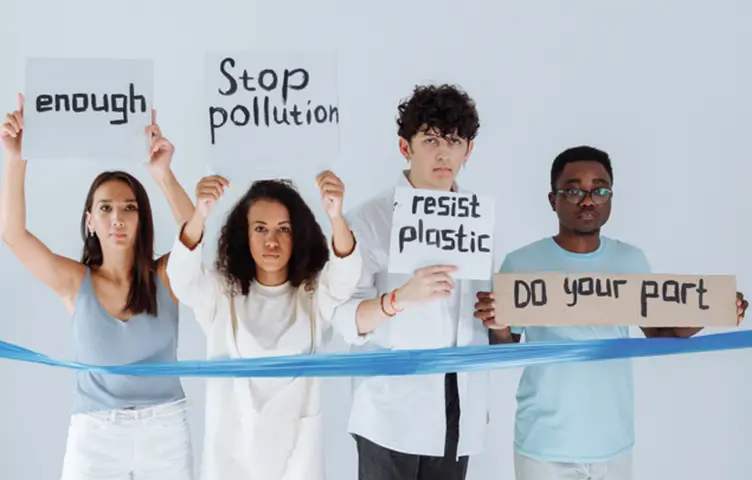|
Getting your Trinity Audio player ready...
|
Environmental justice refers to the fair and equitable distribution of environmental risks and benefits among all communities. The concept emerged in response to the disproportionate burden of environmental harm experienced by marginalised communities. This article aims to explain what is environmental justice, including its:
- History
- Principles
- Intersectionality
- Global perspective
- Challenges
Given the pressing need for sustainability and social equity, understanding and promoting environmental justice is crucial.
To understand the disproportionate burden of environmental harm done to marginalised communities, we must first explain what is meant by the term environmental justice. Put simply, Environmental Justice is the fair and equitable distribution of environmental benefits and risks among all communities.
Environmental justice is a critical issue that has received little attention in mainstream media and education. In this article, we aim to change that by shedding light on the history, principles, intersectionality, global perspective, and challenges.
Environmental injustice affects communities on a global scale. By understanding and promoting, we can work towards a sustainable and equitable future for all.
Join us as we answer the question, what is environmental justice?
History and Context

The social justice movement emerged in the United States in the 1980s in response to the intersection of environmental degradation and systemic racism. The impact of environmental racism on marginalised communities, particularly communities of colour, has been well-documented.
Issue examples include:
- Toxic waste sites
- Industrial pollution
- Climate change
- Access to clean water
- Inadequate waste management systems
- Poverty-related health issues
Understanding the historical context of the movement is essential to understanding its current relevance.
The History of the Environmental Justice Movement
The seeds for the movement were sown as early as the 1970s when people of colour began to recognise the disproportionate impacts of environmental hazards in their communities.
In 1982, a group of African American women from rural North Carolina organised a protest against a hazardous waste landfill which was being built near their homes. This was the first documented case of collective action taken on behalf of environmental justice issues.
Today, the movement is stronger than ever – with countless organisations worldwide striving for equitable access to clean air, water, and land.
Environmental Racism and how it affects Marginalised Communities
Environmental justice is often characterised by racism. It involves the unfair treatment of some populations due to their race or ethnicity regarding access to clean air, water and green spaces.

Studies show African Americans and Hispanics suffer from greater exposure to pollution than other groups. Scientists calculated the two groups are exposed to 63% and 56% more polluted air than white Americans, respectively.
This result has devastating consequences for public health and the overall quality of life amongst these communities.
Examples of Environmental Justice Issues
To paint a picture of what environmental justice issues look like in real life, here are a couple of case scenarios:
- In Flint, Michigan, the city’s water supply was contaminated with lead. This created a public health crisis that disproportionately affected low-income residents and people of colour in the city with limited access to clean drinking water.
- African American and Latino communities living near “Cancer Alley” in Los Angeles, CA, face industrial plants releasing hazardous chemicals. Sadly, these citizens now have high cancer rates due to prolonged exposure.
Understanding Environmental Justice
Defining the principles is essential to comprehend its importance. The concepts include a focus on impacted communities, democratic decision-making, and prevention of harm. When applied consistently, these guidelines provide the framework for promoting sustainability and social equity.
Environmental Justice defined
How can we best explain what is meant by the term environmental justice? We’ll keep it short and sweet.
The concept emphasises the need for all people, regardless of race or income level, to have access to clean air, safe water, and healthy land. In other words, it’s about ensuring that people can live in environments free from pollution and environmental hazards.
Principles of Environmental Justice

Every movement requires a strong foundation. Here are the basic tenets upon which it is based:
- Respect for impacted communities: Ensure everyone has a voice in decisions impacting the environment and their health.
- Democratic decision-making: Give all interested parties an opportunity to participate in crafting solutions.
- Prevention of harm: Prioritise prevention over response, meaning plans should aim to avoid environmental harm before it occurs.
- Equity and fairness: Recognize that not everyone is equally affected by environmental issues, so resources must be shared equitably between those with different levels of access or exposure to pollution and other hazards.
- Right to self-determination: Communities should have the power to decide what happens in their own backyard regarding environmental stewardship.
- Right to a healthy environment: Everyone is entitled to clean air, water, and other necessary resources for a safe and healthy life.
Why Environmental Justice is essential for Sustainability and Social Equity
Environmental justice helps protect the vulnerable, children, elders, and those with chronic illnesses who may be disproportionately affected by environmental hazards.
Additionally, it can reduce disparities in exposure to hazardous materials and access to resources like healthy food or green space. These opportunities ensure that everyone has the same access to a thriving, sustainable environment.
The Intersectionality of Environmental Justice
Environmental injustice is connected to other forms of systemic inequality, including racism, classism, and sexism. Intersectionality is critical in promoting inclusive decision-making processes that prioritise the voices of impacted communities.
The connection between Environmental Justice and other Social Justice Issues
It’s a broad concept covering multiple aspects of societal inequality. For example, women often face higher levels of poverty than men due to gender-based discrimination.
Likewise, lower-income communities may experience a greater burden from air pollution or hazardous waste sites than wealthier areas do. That is because of their limited access to resources and decision-making power.
These issues are integral to environmental justice and must be addressed to create a more equitable society.
How Environmental Justice can address Systemic Inequalities
It may seem overwhelming to address all the inequalities we face. Yet there are simple action steps we can take to make a huge difference. They include:
- Reducing pollution and its impacts on vulnerable communities.
- Allocating resources more equitably.
- Providing access to clean, safe drinking water.
- Ensuring everyone has access to green spaces.
- Working with local organisations that advocate for environmental justice.
- Building public awareness of environmental injustices and solutions.
- Prioritising economic development that is environmentally friendly.
- Enforcing existing environmental regulations and creating new ones where needed.
- Establishing community-driven decision-making processes to ensure fair outcomes.
Enforcing these fundamentals with consistency will be the driving force for change in future environmental policies.
The importance of Inclusive Decision-making Processes
We must include those most affected by decisions around the environment in the process itself. Community leaders should be consulted when making decisions, as they have first-hand experience with their local communities’ issues and can provide valuable insight into possible solutions.
An inclusive approach also helps build trust between stakeholders and encourages collaboration towards finding viable solutions. By listening to all perspectives, we better understand how an issue affects different groups in different ways.
Global Perspective
Environmental justice issues and initiatives are not geographically limited. Environmental harm affects communities globally, and international agreements, such as the Paris Agreement, promote the principles. This section will examine issues and initiatives on a global scale and the role of international agreements in promoting environmental justice.
Global Environmental Justice Issues and Initiatives
Here are three major issues and initiatives related to environmental justice around the world:
- Climate change disproportionately affects marginalised communities around the globe. Various countries have ratified the Paris Agreement to address this issue, which seeks to reduce global emissions and create a more sustainable future.
- Pollution disproportionately affects low-income communities, often located near factories or areas with high industrial activity. The United Nations Environment Program (UNEP) developed the Environmental Rights Initiative to combat this problem. The program aims to promote equitable access to clean air, water, and soil in all parts of the world.
- Access to natural resources is often limited in developing countries due to inequality between rich and poor regions. The UN’s Sustainable Development Goals seek to resolve this problem by providing access to basic needs such as food, energy, healthcare, education, and sanitation to everyone around the world.
Recognising environmental justice issues from a global perspective and acting can create a more equitable world for all.
The role of International Agreements in Promoting Environmental Justice
International agreements play an important role in protecting and promoting environmental justice. One example is the Aarhus Convention, which helps guarantee everyone has access to information on the environment and can take part in decision-making processes related to it. This agreement also provides for access to courts so citizens can challenge public authorities when their rights are not respected.
Challenges and Solutions
The environmental justice movement faces many obstacles, including institutional barriers and limited funding. However, there are potential solutions to overcome these hurdles.
Challenges facing the Movement.
Environmental justice faces several stumbling blocks, from lack of public knowledge and understanding to inadequate funding. Unfortunately, there is often an unequal distribution of resources between countries, communities, and individuals, which further hampers progress.
Potential solutions to overcome the challenges.
To overcome the many obstacles we face in our struggle against environmental injustices, we must increase the public’s awareness of the issue and create more opportunities for communities to get involved.
Next, we must ensure that those affected by these issues have a voice and access to resources to help them fight back.
Lastly, governments should provide better financial and legislative support to organisations devoted to environmental justice.
Examples of successful Environmental Justice Initiatives
Before we finish, we want to leave you with some inspiring real-world case studies of environmental justice initiatives that made a difference.
- In Bangladesh, a local grassroots organisation worked with the government to establish policies to improve access to safe drinking water for low-income communities. The result was improved public health outcomes for thousands of citizens.
- In India’s Karnataka state, a coalition of community leaders joined forces to protect their forests from illegal logging operations that were damaging the environment and impacting local livelihoods. By working together, they were able to secure long-term protections for their forests.
These examples show how environmental justice can be achieved through practical solutions and collective action.
Final Thoughts
Promoting environmental justice is essential for the health and well-being of all communities. It requires a collective effort from individuals and institutions to prioritise the voices of impacted communities and promote sustainable practices.
The necessity of Promoting Environmental Justice for the health and well-being of all communities
Environmental justice is not just an abstract concept but a pressing issue that impacts the lives and health of communities worldwide. We must recognise the intersectionality of environmental injustice with other forms of systemic inequality, including racism, classism, and sexism.
By acknowledging these connections, we can promote inclusive decision-making processes that prioritise the needs and perspectives of marginalised communities.
Call to action for Individuals and Institutions to Support Environmental Justice Initiatives
It is essential that individuals and institutions work together to support environmental justice initiatives in order to create sustainable solutions for all. Let’s continue this dialogue by ensuring our voices are heard, advocating for change, and taking meaningful steps towards creating a more equitable future.
Final thoughts and recommendations for future efforts
The environmental justice movement’s challenges are daunting, but we have seen examples of successful initiatives that have made a difference in communities. It is up to each of us to do our part in promoting environmental justice principles and advocating for policies that prioritise sustainability and social equity.
As we look towards the future, let us continue to push for progress and a better tomorrow. We owe it to ourselves, our communities, and the planet to create a just and equitable world for all. We can make environmental justice a reality by standing together and acting.
FAQs
Q: What is Environmental Justice?
A: Environmental Justice is the fair and equitable distribution of environmental risks and benefits among all communities. It aims to address the disproportionate burden of environmental harm experienced by marginalised communities.
Q: Why is understanding the history of the environmental justice movement important?
A: Understanding the historical context of the environmental justice movement is essential to understanding its current relevance. The movement emerged in the United States in the 1980s, in response to the intersection of environmental degradation and systemic racism.
Q: How does intersectionality relate to Environmental Justice?
A: Environmental injustice is connected to other forms of systemic inequality, including racism, classism, and sexism. Intersectionality is critical in promoting inclusive decision-making processes that prioritise the voices of impacted communities.
Q: How does the environmental justice movement impact communities globally?
A: Environmental harm affects communities globally, and international agreements, such as the Paris Agreement, promote environmental justice principles. Environmental justice issues and initiatives are not limited to the United States.
Q: What challenges does the environmental justice movement face, and what are the potential solutions?
A: The environmental justice movement faces many challenges, including institutional barriers and limited funding. However, there are potential solutions to overcome these challenges, such as promoting community-led initiatives and partnerships between impacted communities and institutions.

